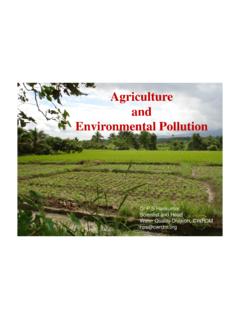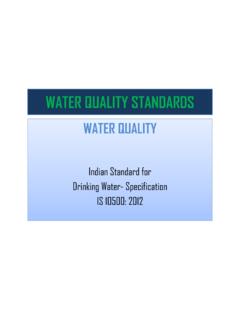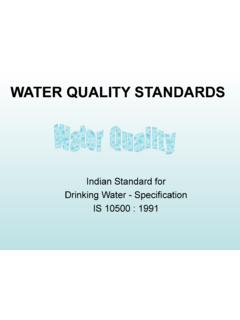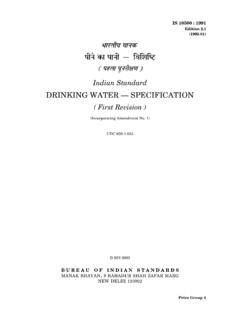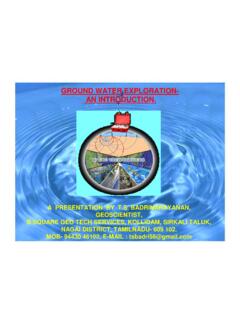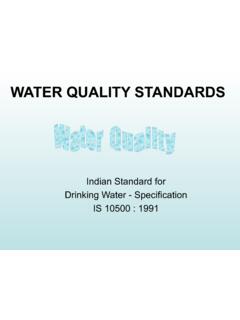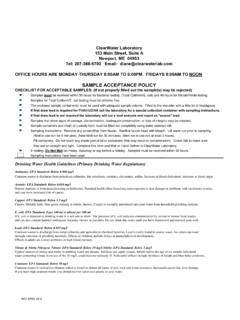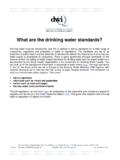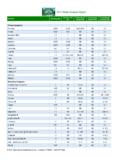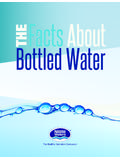Transcription of Tolerance and Classification - India Water Portal | …
1 1 Tolerance and Classification As per ISI-IS: 2296-1982, the Tolerance limits of parameters are specified as per classified use of Water (Table 1,2,3,4,5 below) depending on various uses of Water . The following classifications have been adopted in India . Class of Water Classification Type of use Class A Drinking Water source without conventional treatment but after disinfection Class B Outdoor bathing Class C Drinking Water source with conventional treatment followed by disinfection. Class D Fish culture and wild life propagation Class E Irrigation, industrial cooling or controlled waste disposal 2 Tolerance LIMITS TABLE-1: Tolerance LIMITS FOR INLAND SURFACE WATERS, CLASS A S. No. Characteristic Tolerance (1) (2) (3) (i) pH to (ii) Dissolved Oxygen, mg/l, (iii) Bio-chemical Oxygen Demand (iv) Total Coliform Organisms, MPN/100 ml, Max 50 (v) Colour, Hazen units, Max 10 (vi) Odour unobjectionable (vii) Taste Agreeable taste (viii) Total Dissolved Solids, mg/l, Max 500 (ix) Total Hardness (as CaCO3), mg/l ,Max 300 (x) Calcium Hardness (as CaCO3), mg/l, Max 200 (xi) Magnesium (as CaCO3), mg/1,Max 100 (xii) Copper (as Cu), mg/l, Max (xiii) Iron (as Fe), mg/l,Max (xiv) Manganese (as Mn), mg/1,Max (xv) Chlorides (as Cl), mg/l,Max 250 (xvi) Sulphate (as SO4), mg/l ,Max 400 (xvii) Nitrates (as NO2), mg/1,Max 20 (xviii) Fluorides (as F,) mg/l,Max (xix) Phenolic compounds(as C6H5OH), mg/l,Max (xx) Mercury (as Hg), mg/l ,Max (xxi) Cadmium (as Cd), mg/1,Max (xxii) Selenium (as Se), mg/l ,Max (xxiii) Arsenic (as As), mg/1,Max (xxiv) Cyanides (as CN)
2 , mg/l, Max (xxv) Lead (as Pb), mg/l, Max (xxvi) Zinc (as Zn), mg/l, Max 15 (xxvii) Chromium (asCr6+ ), mg/l,Max (xxviii) Anionic detergents, (as MBAS), mg/l ,Max . (xxix) Poly-nuclear aromatic hydrocarbons (PAH), (xxx) Mineral oil, mg/l ,Max (xxxi) Barium (as Ba), mg/l ,Max (xxxii) Silver (as Ag), mg/l Max (xxxiii) Pesticides Absent (xxxiv) Alpha emitters, c/ml, Max 10-9 (xxxv) Beta emitters, c/ml, Max 10-8 3 TABLE- 2: Tolerance LIMITS FOR INLAND SURFACE WATERS, CLASS B S. No Characteristic Tolerance Limit (1) (2) (3) (i) pH Value to (ii) Dissolved Oxygen, mg/1,Max (iii) Biochemical Oxygen Demand (5 days at 20 C), Max (iv) Total Coliform Organisms, MPN/100 ml, Max 500 (v) Fluorides (as F)<mg/l, Max (vi) Colour, Hazen units, Max 300 (vii) Cyanides (as CN), mg/l, Max (viii) Arsenic (as As), mg/l, Max (ix) Phenolic Compounds (as C6H5OH) mg/l, Max (x) Chromium (as Cr6+), mg/l, Max (xi) Anionic detergents (as MBAS), mg/l, Max (xii) Alpha emitters, c/ml, Max 10-8 4 TABLE - 3.
3 Tolerance LIMITS FOR INLAND SURFACE WATERS, CLASS C Characteristic Tolerance Limit (1) (2) (3) (i) pH Value to (ii) Dissolved Oxygen, mg/l Minimum (iii) Biochemical Oxygen Demand (iv) Total coliform organisms, MPN/100 ml, Max 5000 (v) Colour, Hazen units, Max 300 (vi) Fluorides (as F), mg/l ,Max (vii) Cadmium (as Cd), mg/l, Max (viii) Chlorides (as Cl), mg/l, Max 600 (ix) Chromium (as Cr6+), mg/l, Max (x) Cyanides (as CN), mg/l, Max (xi) Total Dissolved Solids, mg/l, Max 1500 (xii) Selenium (as Se), mg/l, Max (xiii) Sulphates (as SO4), mg/l, Max 400 (xiv) Lead (as Pb), mg/l, Max (xv) Copper (as Cu),mg/l,Max (xvi) Arsenic (as As), mg/l, Max (xvii) Iron (as Fe), mg/l, Max 50 (xviii) Phenolic compounds (as C6H5OH), mg/l, Max (xix) Zinc (as Zn), mg/l, Max 15 (xx) Insecticides, mg/l, Max Absent (xxi) Anionic detergents (as MBAS), mg/l, Max (xxii) Oils and grease, mg/l, Max (xxiii) Nitrates (as NO3), mg/1,Max 50 (xxiv) Alpha emititers, c/mg, Max 10-9 (xxv) Beta emitters, c/ml, Max 10-8 5 TABLE- 4: TEOLERANCE LIMITS FOR INLAND SURFACE WATERS, CALSS D Characteristic Tolerance Limit (1) (2) (3) (i) pH value to (ii) Dissolved Oxygen, mg/l, Min.
4 (iii) Free Ammonia (as N), mg/l, Max. (iv) Electrical Conductance at 25 C, S, Max 1000 (v) Free Carbon Dioxide (as C02),mg/1, Max (vi) Oils and Grease, mg/l, Max (vii) Alpha emitters, c/ml, Max 10-9 (viii) Beta emitters, c/ml, Max 10-8 6 TABLE- 5: Tolerance LIMITS FOR INLAND SURFACE WATERS, CLASS E Characteristic Tolerance Limit (1) (2) (3) (i) pH value to (ii) Electrical Conductance at 25 C, S, Max 2250 (iii) Sodium Adsorption Ratio, Max 26 (iv) Boron (as B), mg/l, Max (v) Total Dissolved Solids, (inorganic), mg/l, Max 2100 (vi) Sulphates (as SO4), mg/l, Max 1000 (vii) Chlorides (as Cl), Mg/l, Max 600 (viii) Sodium Percentage, Max 60 (ix) Alpha emitters, c/ml, Max 10-9 (x) Beta emitters, c/ml, Max 10-8 7 TEST CHARACTERSTICS FOR DRINKING WATERS IS 10500:1991 (Amended) S. No. Substance Characteristic Require-ment* Undesirable effect outside the desirable limit Permissible Limit** A Essential Characteristics 1.
5 Colour, Hazen units, Max Above , consumer acceptance decreases 25 2. Odour Unobject-ionable - - 3. Taste Agreeable - - 4. Turbidity, NTU, Max Above , consumer acceptance decreases 10 5. pH Value To Beyond this range the Water will effect the mucous membrane and/or Water supply system No relaxation 6. Total Hardness, (as CaCO3) mg/l, Max. 300 Encrustations in Water supply structure and adverse effect on domestic use 600 7. Iron (as Fe), mg/l, Max 0. 3 Beyond this limit taste/appearance are affected, has adverse affect on domestic uses and Water supply structures, and promotes iron bacteria 8. Chlorides (as Cl), mg/l, Max 250 Beyond this limit taste, corrosion and palatability are affected 1000 9. Residual free Chlorine, mg/l, Minimum - - B Desirable Characteristics 10. Dissolved Solids, mg/l, Max 500 Beyond this palatability decreases and may cause Gastro intestinal irritation 2000 11 Calcium (as Ca) mg/l, Max. 75 Encrustations in Water supply structure and adverse effect on domestic use 200 12.
6 Magnesium (as Mg) mg/l, Max 30 Encrustations in Water supply structure and adverse effect on domestic use 100 13. Copper (as Cu), mg/l, Max Astringent taste, discoloration and corrosion of pipes, fitting and utensils will be caused beyond this 14. Manganese (as Mn) mg/l, Max Beyond this limit, taste/appearance are affected, has adverse effect on domestic use and Water supply structure. 8 15. Sulphates (as SO4), mg/l, Max 200 Beyond this causes Gastro intestinal irritation when magnesium or sodium are present 400 16. Nitrate (as NO3) mg/l, Max. 45 Beyond this methaemoglobinemia takes place. 100 17. Fluorides (as F), mg/l, Max Fluoride may be kept as low as possible. High fluoride may cause fluorosis 18 Phenolic compounds (as C6H5OH), mg/l, Max Beyond this, it may cause objectionable taste and odour 19. Mercury (as Hg), mg/l, Max Beyond this, the Water becomes toxic No relaxation 20. Cadmium (as Cd), mg/l, Max Beyond this, the Water becomes toxic No relaxation 21.
7 Selenium (as Se), mg/l, Max Beyond this, the Water becomes toxic No relaxation 22. Arsenic (as As), mg/l, Max Beyond this, the Water becomes toxic No relaxation 23. Cyanides (as CN), mg/l, Max Beyond this, the Water becomes toxic No relaxation 24. Lead (as Pb), mg/l, Max Beyond this, the Water becomes toxic No relaxation 25. Zinc (as Zn), mg/l, Max Beyond this limit, it can cause astringent taste and an opalescence in Water 15 26. Anionic detergents (as MBAS), mg/l, Max Beyond this limit, it can cause a light froth in Water 27. Chromium (as Cr6+), mg/l, Max May be carcinogenic above this limit No relaxation 28. Polynuclear aromatic hydrocarbons (as PAH), mg/l, Max - May be carcinogenic - 29. Mineral Oil, mg/l, Max Beyond this limit, undesirable taste and odour after chlorination take place 30. Pesticides mg/l, Max Absent Toxic 31. Alpha emitters, Bq/l, Max - - 9 32. Beta emitters, pCi/l, Max - - 33. Alkalinity mg/l, Max 200 Beyond this limit, taste becomes unpleasant 600 34.
8 Aluminum (as Al) mg/l, Max Cumulative effect is reported to cause dementia 35. Boron mg/l, Max - No sample should contain E. Coli in 100 ml.; No sample should contain more than 10 coliform organisms per 100 ml; and Coliform organisms should not be detectable in 100 ml of any two consecutive samples. * Desirable limit ** in absence of alternate source
